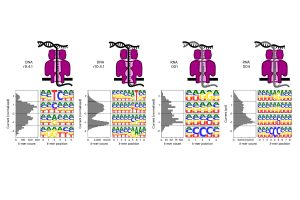
Johns Hopkins researchers have developed Uncalled4, a new software toolkit that can detect epigenetic changes—chemical modifications to normal DNA and RNA that control which genes are turned off and on—with unprecedented accuracy. Because these changes play a key role in disease development and treatment responses, Uncalled4 has the potential for broad applications in cancer research, drug development, and personalized medicine. The team’s results,”Uncalled4 improves nanopore DNA and RNA modification detection via fast and accurate signal alignment,” appear in Nature Methods.
The software analyzes and visualizes data from nanopore sequencing, which reads DNA and RNA molecules by detecting electrical signals as molecules pass through tiny pores. Epigenetic modifications subtly alter these signals, but accurately identifying them has been a challenge—until now. Uncalled4 offers a fast, precise solution, enabling researchers to detect and analyze these modifications with greater accuracy and efficiency.
“The key to Uncalled4 is a new, high-performance alignment algorithm for comparing the electrical readout from DNA or RNA molecules to the electrical signal derived from a reference genome. With these improved alignments, even small changes can be reliably detected, leading to the more complete and precise detection of epigenetic modifications in DNA and RNA,” explains senior author Michael Schatz, the Bloomberg Distinguished Professor of Computational Biology and Oncology.
Uncalled4 provides an end-to-end solution for this analysis, offering computer tools and interactive visual displays that help researchers match electrical signals to DNA sequences, train better detection systems, and compare different analysis methods. The software has already led to the discovery of errors in existing nanopore sequencing models, the researchers say.
The suite also introduces a new algorithm that maps genetic data faster and more accurately than existing approaches and saves its results in a format that other researchers can easily use, according to the team.
Using Uncalled4, the team was able to identify 26% more RNA modifications in human cell lines compared to previous methods—including key modifications in genes associated with cancer.
“I think one of the most exciting opportunities will be how this software can be used to improve our understanding of how cancer develops—particularly how epigenetic changes can cause abnormal cell growth by incorrectly turning genes on or off,” Schatz says. “Mapping out where these epigenetic changes occur is crucially important to understanding both healthy development and disease progression.”
The toolkit is open-source and freely available on GitHub, making it a valuable resource for researchers worldwide who are studying genomic modifications in diverse biological contexts. The researchers have already had discussions with groups interested in building on the software to investigate other types of modifications in humans, plants, and other animals.
“By making Uncalled4 openly available, we aim to accelerate discoveries in fields ranging from epigenetics to disease diagnostics,” Schatz says. “Our hope is that others will be able to build on our work to help answer outstanding questions in pressing fields like cancer research.”
This research was supported by the National Cancer Institute, the National Human Genome Research Institute, the National Science Foundation, and the Lustgarten Foundation for Pancreatic Cancer Research.
Additional authors of this work include CS PhD student Vikram Shivakumar; former postdoctoral fellows Sam Kovaka and Katharine M. Jenike; the Department of Biomedical Engineering’s Paul W. Hook, Luke B. Morina, and Winston Timp; and Roham Razaghi, Med ’22 (PhD).